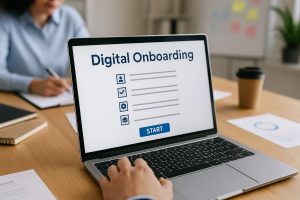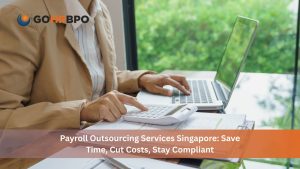Introduction
Let me tell you why we left paper onboarding behind. You know, earlier, we used to handle onboarding the old-fashioned way- paper forms, in-person sessions, and all that.
It was fine back when everyone was in the office every day. But once a hybrid setup came into the scene, things got a little weird, and paper onboarding just didn’t make sense anymore. Things got messed up, slowed down, and honestly, made new hires feel a bit lost and confused.
That is how, and when, digital onboarding started to matter more, and I have to say it really changed everything. This way, new team members get to work as soon as they join, and everything is more organized.
Also, let me tell you that companies that use digital onboarding see more productivity and better retention. So if you’re still doing it manually, I seriously suggest you give it a try.

Why Digital Onboarding Matters
One of the biggest issues with manual onboarding is that things often get delayed or missed. There are many teams like HR, IT, legal, and managers, so with different teams involved, it is very easy for important steps to fall through the cracks.
Also, sometimes it is possible for new hires to not be able to get all the information they need, or things often get out of order. It creates confusion and sometimes leaves a poor first impression.
But then, if you switch to digital onboarding, all of this changes. It brings everything to one place and automates a lot of repetitive work, which helps you to create a good experience for every new hire, no matter where they are located or which department they are working for.
You know, companies with strong onboarding processes see an 82% improvement in new hire retention and a 70% boost in productivity. Honestly, based on what I have seen, this feels pretty accurate.
Also Read: Understanding Employee Travel Allowances in Singapore: Compliance, Taxation, and Best Practices
Essential Tools for Digital Onboarding
HR Management Systems
If you’re thinking of going digital with onboarding, a good HRMS is really what you need. These tools take care of the basics for you, like document submission and onboarding, and they also give automated reminders for managers.
E-Signature and Document Management
This is a game-changer. There are tools like DocuSign or Adobe Sign that let new hires sign contracts, NDAs, and policies from anywhere. You don’t even need to print or scan anything. Like this, everything is secure, and there is a clear audit trail, which really helps with compliance.
Identity Verification Tools
If you are in a regulated industry like finance or healthcare, this is important. Tools like Onfido and Jumio verify a person‘s identity using AI and facial recognition. It also speeds up KYC checks and helps cut down on errors or fraud. They are the greatest when you need quick and reliable ID checks during onboarding.
Learning Management Systems
Now, it is very important to make sure that new employees learn new things quickly. LMS platforms like Docebo or Moodle help you with that. You can upload training modules, videos, and quizzes to these platforms, which in turn can be very useful to the employees.
Collaboration and Communication Tools
Collaboration and communication tools are very useful for remote or hybrid teams. You can use tools like Slack or Microsoft Teams to introduce new team members to each other, answer their questions, and check in with them. Sometimes teams also give new hires an “onboarding buddy” who helps them feel welcome and gives support in the beginning.
Analytics and Feedback Tools
After a new person joins, it is important to know how their own boarding went. Tools like Culture Amp or TINYpulse let you send short surveys to ask for their thoughts. This helps you see what is working, what is not, and how you can make the process better for others in the future.
Top Digital Onboarding Trends to Watch
Preboarding
One thing I find really useful is pre-boarding. This means staying in touch with new hires from the time they accept their job until their first day. Some companies send things like welcome kits, their schedule for their first week, and also training links before they even start. Don’t you think it helps employees feel excited and know what to expect when they join?
AI and Automation
AI has really started to make a difference in onboarding. Now, bots can answer common questions, send reminders to employees, and even personalize training based on someone’s role or location.
Gamification
This one is really interesting. Some companies are actually turning onboarding into a game to make it more fun. For example, Accenture built this virtual campus called One Accenture Park. Here, new hires can explore office spaces with VR and complete training tasks, kind of like quests in a game. It helped them onboard over 45,000 people globally.
Remote/Hybrid Adaptation
It is well known that hybrid work isn’t going anywhere any time soon, so onboarding really has to feel more personal, even if it is happening online. I have seen companies do things like virtual coffee, charts, breakout rooms, and even share video libraries. I think it really helps new hires feel like they are part of the team, even when they are not in the same place as everyone else.
Personalization and Flexibility
Now, personalisation is something that is very important when it comes to onboarding because it is different for everyone. There are many platforms that let you make content for someone based on their job or where they work, or how much experience they have.
Well-Being and Inclusion
It is also great to see more focus on mental health and inclusion nowadays. Companies like Microsoft are leading the way by adding things like DEI training, optional wellness sessions, and tips on inclusive communication into their own training. It sends a strong message that the company genuinely cares.
Continuous Onboarding
Finally, onboarding isn’t just a one-week process anymore. More companies are treating it as an ongoing journey. That means offering follow-up training, development programs, and regular feedback check-ins even months after someone starts. It is a great way to support career growth and internal mobility over time.
PeopleCentral- Setting the Benchmark for Smart Onboarding
If you ask me, I’ll say PeopleCentral really stands out when it comes to digital onboarding, especially here in the Asia Pacific region. If you are looking for something that is both powerful and easy to use, this platform is what you need. Here is what makes it work so well:
Fully mobile-compatible workflow: New hires can complete tasks right from their phone, which is super helpful, especially for remote teams of people who are always on the go.
Seamless integration with payroll and HR analytics: It connects everything like payroll, HR data, and onboarding tasks so that you don’t have to jump between different systems or worry about errors.
Automated task assignment and document handling: The system assigns tasks and keeps all the documents in one place, so that nothing gets missed. Now you don’t have to follow up or chase people for forms.
Detailed dashboard to track progress and spot bottlenecks: HR can see exactly where each new hire is in the process. If something is stuck, they can step in and fix it quickly.
Also Read: Step-by-Step Guide to Submitting Reimbursement Claims
People Central ensures your onboarding process is smooth, compliant, and future-ready.
Conclusion
At this point, it is pretty clear that digital onboarding is a smart investment in both your people and your processes. When you have the right tools, onboarding is actually smooth, engaging, and something new hires will remember for the right reasons.
So if you are looking at your current onboarding process and thinking, “We could probably do better,” you are not alone. Now is a great time to take that step forward.






